1. Introduction to The Fractions
- Books Name
- CBSE Class 6 Mathematics Book
- Publication
- Param Publication
- Course
- CBSE Class 6
- Subject
- Mathmatics
Fractions
A fraction is a number representing a part of a whole. It is written as ![]() where a is the numerator and b is the denominator.
where a is the numerator and b is the denominator.
![]()

Fraction as a Part of a Whole :
If a birthday cake is divided into four equal parts, each part is represented as 1 part out of 4 equal parts and is written as ![]()
The part that is considered (in this case, 1) is called the numerator. The number of parts into which the whole is divided (in this case, 4) is called the denominator.
![]() is a fraction. We read it as “five-twelfths”. Here 12 stands for the number of equal parts into which the whole has been divided and 5 stands for the number of equal parts which have been taken out.
is a fraction. We read it as “five-twelfths”. Here 12 stands for the number of equal parts into which the whole has been divided and 5 stands for the number of equal parts which have been taken out.
Here 5 is called the numerator and 12 is called the denominator.
Ex. What fraction of a day is 9 hours?
Sol. One day = 24 hours

i.e., 9 hours out of 24 hours.
![]()
Fraction on the Number Line
In previous chapters we learnt to show whole numbers like 0,1,2... on a number line. We can also show fractions on a number line. Let us draw a number line and we try to mark ![]()
is greater than 0 and less than 1, so it should lie between 0 and 1.
Since we have to show ![]() we divide the gap between 0 and 1 into two equal parts and show 1 part as
we divide the gap between 0 and 1 into two equal parts and show 1 part as ![]() (As shown in figure)
(As shown in figure)

Suppose we want to show ![]() on a number line. We divide the length between 0 and 1 into 3 equal partsand show one part as
on a number line. We divide the length between 0 and 1 into 3 equal partsand show one part as ![]() (as shown in the Figure)
(as shown in the Figure)

2. Fraction and its Classification
- Books Name
- CBSE Class 6 Mathematics Book
- Publication
- Param Publication
- Course
- CBSE Class 6
- Subject
- Mathmatics
Types of Fractions
(i) Proper Fractions : A proper fraction is a fraction in which the numerator is smaller than the denominator.

(ii) Improper Fractions : An improper fraction is a fraction in which the numerator is greater than the denominator.

(iii) Mixed fraction : Fractions such as ![]() are called Mixed Fractions. A mixed fraction has a combination of a whole and a part.
are called Mixed Fractions. A mixed fraction has a combination of a whole and a part.
Ex. Express the following as mixed fraction :

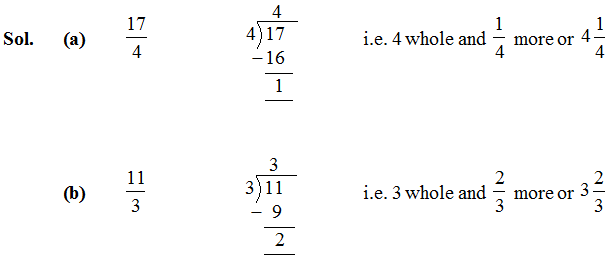
Conversion of Mixed Fractions into Improper Fractions
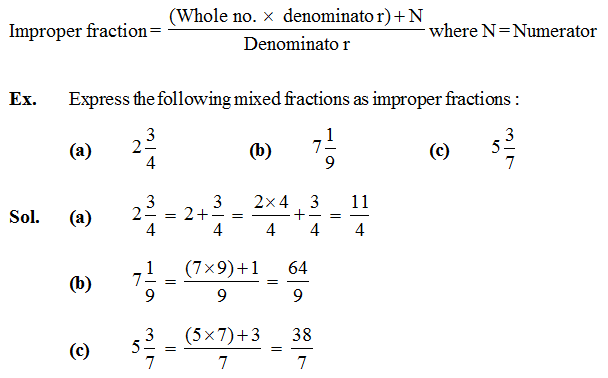
3. Addition and Subtraction of Fractions
- Books Name
- CBSE Class 6 Mathematics Book
- Publication
- Param Publication
- Course
- CBSE Class 6
- Subject
- Mathmatics
Equivalent Fractions
Let us take some pictorial representation of fraction.

These fractions are  representing the parts taken from the total number of parts. If we place the pictorial representation of one over the other they are found to be equal.
representing the parts taken from the total number of parts. If we place the pictorial representation of one over the other they are found to be equal.
These fractions are called equivalent fractions.
Understanding equivalent fractions

They represent the same part of a whole.
There are two ways of obtaining equivalent fractions.
(a) By multiplying its numerator and denominator by the same number.

(b) By dividing its numerator and denominator by the same number.


Sol.: We know 2 × 3 = 6. This means we need to multiply both the numerator and the denominator by 3 to get the equivalent fraction.

Simplest Form of a Fraction
A fraction is said to be in the simplest (or lowest) form if its numerator and denominator have no common factor except 1.
The shortest way
The shortest way to find the equivalent fraction in the simplest form is to find the HCF of the numerator and denominator, and then divide both of them by the HCF.


Like and Unlike Fractions
- Books Name
- CBSE Class 6 Mathematics Book
- Publication
- Param Publication
- Course
- CBSE Class 6
- Subject
- Mathmatics
Like and unlike Fractions
Fractions with same denominators are called like fractions.



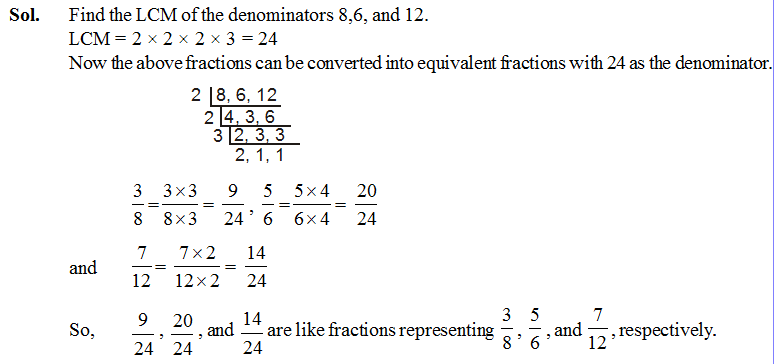
Comparing Fractions
- Books Name
- CBSE Class 6 Mathematics Book
- Publication
- Param Publication
- Course
- CBSE Class 6
- Subject
- Mathmatics
Comparing Fractions
For comparing two or more fractions, First we check their numerator and denominator with each other i.e. they are like or unlike.
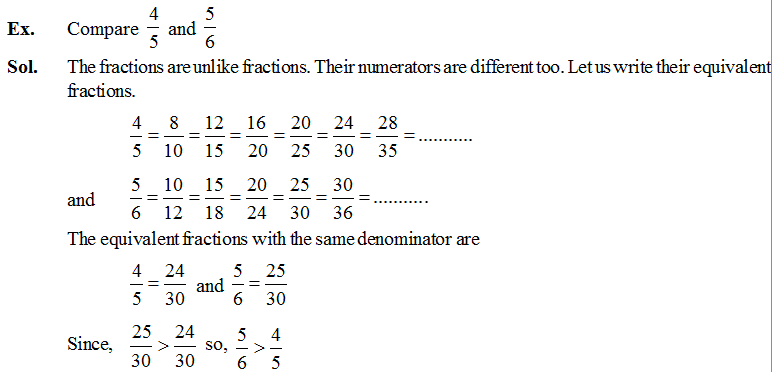
So, when we compare two unlike fractions, we first get their equivalent fractions with a denominator which is a common multiple of the denominators of both the fractions.

Adding and Subtracting Fractions
- Books Name
- CBSE Class 6 Mathematics Book
- Publication
- Param Publication
- Course
- CBSE Class 6
- Subject
- Mathmatics
Adding and subtracting fractions
Addition and subtraction is performed in like fractions. It is also not very difficult to add fractions that do not have the same denominator. When we have to add or subtract fractions we first find equivalent fractions with the same denominator and then proceed.

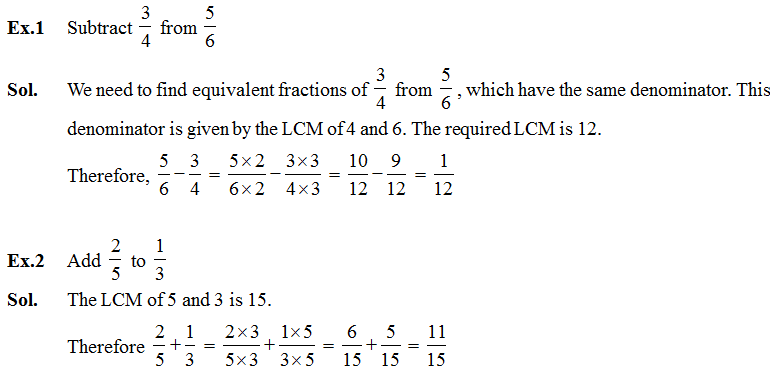
Adding and Subtracting with Mixed Fractions
- Books Name
- CBSE Class 6 Mathematics Book
- Publication
- Param Publication
- Course
- CBSE Class 6
- Subject
- Mathmatics
Addition and subtraction with mixed fractions
Mixed fractions can be written either as a whole part plus a proper fraction or entirely as an improper fraction. One way to add (or subtract) mixed fractions is to do the operation seperately for the whole parts and the other way is to write the mixed fractions as improper fractions and then directly add (or subtract) them.
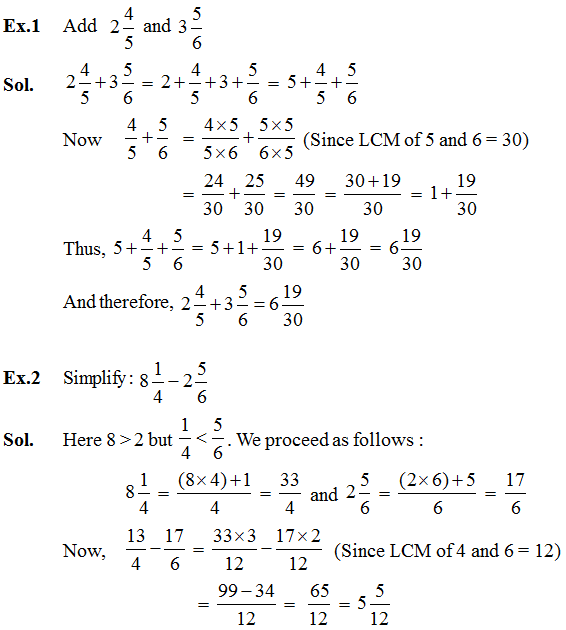
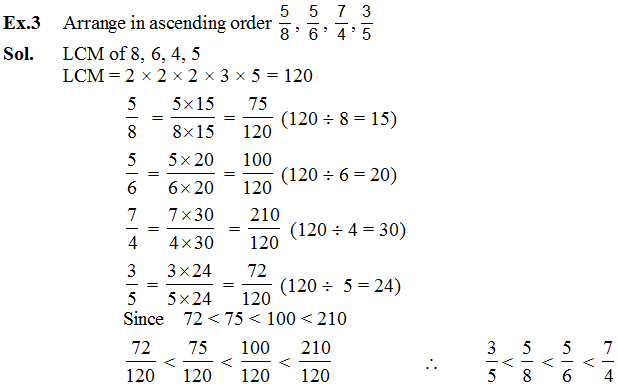

 ReginaTagebücher
ReginaTagebücher
 Param Publication
Param Publication
